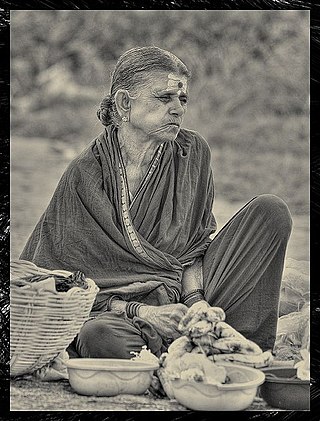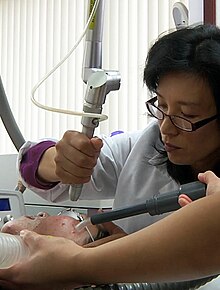
A scar is an area of fibrous tissue that replaces normal skin after an injury. Scars result from the biological process of wound repair in the skin, as well as in other organs, and tissues of the body. Thus, scarring is a natural part of the healing process. With the exception of very minor lesions, every wound results in some degree of scarring. An exception to this are animals with complete regeneration, which regrow tissue without scar formation.
Intense pulsed light (IPL) is a technology used by cosmetic and medical practitioners to perform various skin treatments for aesthetic and therapeutic purposes, including hair removal, photorejuvenation as well as to alleviate dermatologic diseases such as acne. IPL is increasingly used in optometry and ophthalmology as well, to treat evaporative dry eye disease due to meibomian gland dysfunction.

Laser hair removal is the process of hair removal by means of exposure to pulses of laser light that destroy the hair follicle. It had been performed experimentally for about twenty years before becoming commercially available in 1995–1996. One of the first published articles describing laser hair removal was authored by the group at Massachusetts General Hospital in 1998. Laser hair removal is widely practiced in clinics, and even in homes using devices designed and priced for consumer self-treatment. Many reviews of laser hair removal methods, safety, and efficacy have been published in the dermatology literature.

Hyperpigmentation is the darkening of an area of skin or nails caused by increased melanin.
Dermabrasion is a type of surgical skin planing, generally with the goal of removing acne, scarring and other skin or tissue irregularities, typically performed in a professional medical setting by a dermatologist or plastic surgeon trained specifically in this procedure. Dermabrasion has been practiced for many years and involves the controlled deeper abrasion of the upper to mid layers of the skin with any variety of strong abrasive devices including a wire brush, diamond wheel or fraise, sterilized sandpaper, salt crystals or other mechanical means.

An Er:YAG laser (erbium-doped yttrium aluminium garnet laser, erbium YAG laser) is a solid-state laser whose active laser medium is erbium-doped yttrium aluminium garnet (Er:Y3Al5O12). Er:YAG lasers typically emit light with a wavelength of 2940 nm, which is infrared light.
Facial rejuvenation is a cosmetic treatment, which aims to restore a youthful appearance to the human face. Facial rejuvenation can be achieved through either surgical and/or non-surgical options. Procedures can vary in invasiveness and depth of treatment. Surgical procedures can restore facial symmetry through targeted procedures and facial restructuring and skin alterations. Non-surgical procedures can target specific depths of facial structures and treat localized facial concerns such as wrinkles, skin laxity, hyperpigmentation and scars.

In cosmetology, exfoliation is the removal of the surface skin cells and built-up dirt from the skin's surface. The term comes from the Latin word exfoliare. This is a regular practice within the cosmetic industry, both for its outcome of promoting skin regeneration as well as providing a deep cleanse of the skin barrier. Being used in facials, this process can be achieved by mechanical or chemical means, such as microdermabrasion or chemical peels. Exfoliants are advertised as treatments that enhance beauty and promote a youthful and healthy appearance.
Laser surgery is a type of surgery that uses a laser to cut tissue.

Photoaging or photoageing is a term used for the characteristic changes to skin induced by chronic UVA and UVB exposure. Tretinoin is the best studied retinoid in the treatment of photoaging.

Laser medicine is the use of lasers in medical diagnosis, treatments, or therapies, such as laser photodynamic therapy, photorejuvenation, and laser surgery.

Actinic elastosis, also known as solar elastosis, is an accumulation of abnormal elastin in the dermis of the skin, or in the conjunctiva of the eye, which occurs as a result of the cumulative effects of prolonged and excessive sun exposure, a process known as photoaging.

Fraxel Laser Treatment is a line of lasers developed by Reliant Technologies in 2004. It was developed from a US patent licensed from the Wellman Center for Photomedicine. R. Rox Anderson was the inventor. Fraxel lasers cause fractional photothermolysis for skin resurfacing.
Radio-frequency skin tightening is an aesthetic technique that uses radio frequency (RF) energy to heat skin with the purpose of stimulating cutaneous collagen, elastin and hyaluronic acid production in order to reduce the appearance of fine lines and loose skin. The technique induces tissue remodeling and production of new collagen and elastin. The process provides an alternative to facelift and other cosmetic surgeries.
Cameron K. Rokhsar is an associate clinical professor of dermatology at Mount Sinai Hospital and the founder and medical director of the New York Cosmetic, Skin, and Laser Surgery Center. He is a fellowship-trained cosmetic and mohs surgeon, a specialist in laser surgery including laser resurfacing and laser treatment of wrinkles and scars.

Yoram Harth is an Israeli dermatologist and inventor. He co-invented blue light acne vulgaris phototherapy, as well as a radio frequency device for home treatment for wrinkle reduction.

Venkataram Mysore is a dermatologist, dermatopathologist, and hair transplant surgeon from Bangalore, India. He has over 30 years experience as a dermatologist, 18 years as a teacher and is currently the director of the Venkat Center for Advanced Dermatology and Post-Graduate Training.
Laser-assisted drug delivery (LADD) is a drug delivery technique commonly used in the dermatology field that involves lasers. As skin acts as a protective barrier to the environment, the absorption of topical products through the epidermis is limited; thus, different drug delivery modalities have been employed to improve the efficacy of these treatments. The use of lasers in LADD has been shown to enhance the penetration of drugs transdermal, leading to a higher absorption rate, limited systemic effects, and reduced duration of treatment. Although this technique has evolved in the past decade due to its efficacy through scientific research and clinical practice, there remain some limitations regarding the safety aspect that needs to be taken into consideration.
Tina S. Alster, MD, FAAD, is an American dermatologist, educator, researcher, and author. Alster specializes in dermatologic laser surgery and cosmetic dermatology. She is the founding director of her skin care clinic, the Washington Institute of Dermatologic Laser Surgery, and is a Clinical Professor of Dermatology at Georgetown University Medical Center in Washington, D.C.
An Er:glass laser is a solid-state laser whose active laser medium is erbium-doped glass. Ytterbium (Yb) is sometimes added to these lasers to improve their efficiency. Er:glass lasers emit light in the infrared region of the electromagnetic spectrum, often in the range of 1530–1560 nanometers.











